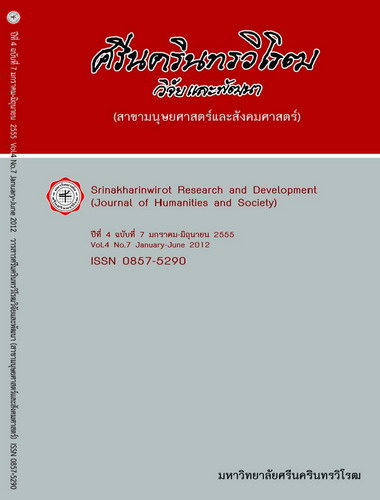วิเคราะห์ภาษาในแผ่นพับโฆษณาเครื่องสำอาง ปี พ.ศ. 2551 (AN ANALYSIS OF LANGUAGE IN COSMETIC ADVERTISING FLIERS IN 2008)
Keywords:
Verbal Language, Non-Verbal Language, Cosmetic advertising fliers, CosmeticAbstract
บทคัดย่อ งานวิจัยนี้มีจุดมุ่งหมายเพื่อให้เห็นวัจนภาษาและอวัจนภาษาที่มีลักษณะเฉพาะในแผ่นพับโฆษณาเครื่องสำอาง และเพื่อศึกษาให้เห็นความสัมพันธ์ระหว่างวัจนภาษาและอวัจนภาษาในแผ่นพับโฆษณาเครื่องสำอาง โดยเสนอผลการวิจัยแบบพรรณนาวิเคราะห์
ผลการศึกษาพบว่า ภาษาในแผ่นพับโฆษณาเครื่องสำอาง ปี พ.ศ. 2551 ด้านวัจนภาษามีทั้งหมด 2 ส่วน ได้แก่
1. พาดหัวโฆษณา ซึ่งพบว่า มี 2 ประเภท คือ พาดหัวหลักและพาดหัวรอง ผลการศึกษาพบว่า พาดหัวหลักมีการใช้กลวิธีที่น่าสนใจทั้งสิ้น 15 กลวิธี โดยใช้พาดหัวแบบข่าว ประเภทพาดหัวแบบข่าวเพื่อสื่อข่าวสารเรื่องผลิตภัณฑ์ตัวใหม่มากที่สุด ส่วนพาดหัวรองพบว่า พาดหัวรองมีหน้าที่ 2 ลักษณะ ได้แก่ ทำหน้าที่บอกชื่อรุ่นของผลิตภัณฑ์ และทำหน้าที่อธิบายคุณสมบัติของผลิตภัณฑ์ ซึ่งพบพาดหัวรองที่ทำหน้าที่อธิบายคุณสมบัติของผลิตภัณฑ์มากที่สุด
2. ข้อความอธิบายรายละเอียดพบว่า มีการใช้คำ การใช้ภาพพจน์ และการใช้ประโยคข้อความอธิบายรายละเอียดที่เป็นคำพบว่า มีลักษณะการใช้คำที่เด่น 2 ลักษณะ คือ 1) การใช้คำเพื่ออธิบายรายละเอียดของเครื่องสำอาง และ 2) การใช้คำเพื่อโน้มน้าวใจ
ข้อความอธิบายรายละเอียดที่เป็นภาพพจน์พบว่า มีการใช้ภาพพจน์ที่เด่น 3 ประเภท คือ 1) อุปมา ซึ่งพบว่า มีการใช้มากที่สุด 2) อติพจน์ 3) บุคคลวัต
ข้อความอธิบายรายละเอียดที่เป็นประโยคพบว่า มีการใช้ประโยคเพื่อแสดงเจตนา 3 ประเภท ได้แก่ 1. ประโยคแจ้งให้ทราบ จำแนกเป็น 1) ประโยคบอกเล่า 2) ประโยคอธิบาย 3) ประโยคชี้แนะ 2. ประโยคถามให้ตอบ จำแนกเป็น 1) ประโยคถามให้ตอบเนื้อความ 2) ประโยคถามให้ตอบรับหรือปฏิเสธ 3. ประโยคบอกให้ทำ จำแนกเป็น 1) ประโยคคำสั่ง 2) ประโยคชักชวน
ด้านอวัจนภาษาพบว่า มีการใช้อวัจนภาษาที่เด่นในด้านการใช้ภาพ การใช้สี การใช้ตัวอักษร และการใช้เครื่องหมายการค้าและตรารับรอง
ด้านความสัมพันธ์ระหว่างวัจนภาษาและอวัจนภาษาในแผ่นพับโฆษณาเครื่องสำอาง ปี พ.ศ. 2551 จากการศึกษาความสัมพันธ์ของอวัจนภาษา 3 ด้าน คือ 1) การใช้ภาพ 2) การใช้สี 3) การใช้ตัวอักษร กับการใช้วัจนภาษาพบว่า มีความสัมพันธ์ 3 ประเภท คือ 1) แบบเสริมกันมากที่สุด 2) แบบซ้ำกัน และเสริมกัน 3) แบบแย้งกัน
Abstract
The aim of this thesis is to examine the characteristics of verbal and non-verbal languages used in cosmetic advertising fliers, and also the relationship between the two languages in cosmetic advertising fliers. The result is presented in descriptive analysis.
The study found that the verbal language in cosmetic advertising fliers in A.D. 2008 can be categorized into two parts:
1. Advertisement headlines which can be divided into two types, the main headline and the sub-headline. The data indicated that there are fifteen techniques to use the main headlines; the most frequent is news headline to introduce new products. The sub-headline has into two functions – 1) to indicate the product’s model, and 2) to explain the product’s qualifications. The latter is found to be the most common.
2. The study found that words, figure of speech, and sentences are used to describe product’s details.
The words used in the description have two distinguished characters: 1) they were used to describe the cosmetics’ features, and 2) they were used to persuade customer.
The figure of speech found in the depiction of the products includes three dominant forms: 1) Simile, which appeared to be the most frequently used, 2) Hyperbole, and 3) Personification.
The use of sentences to describe the details in the body copy demonstrated three meanings:
1. Informative sentences including 1) declarative sentence, 2) explanatory sentence, and 3) advising sentence.
2. Interrogative sentences including 1) WH – questions requiring content reply, and 2) Yes-No questions requiring accepting or denying answer.
3. Imperative sentences incorporating 1) order sentence, and 2) persuasive sentence.
This research reveals that the usage of images, colors, alphabets, trademarks, and approval stamps are the prevalent forms of non-verbal language.
Regarding relationship between verbal and non-verbal languages used in 2008 cosmetics advertisement fliers, the study discovered the three aspects of non-verbal language- 1) images, 2) colors, and 3) alphabets-build three forms of relationship with verbal language. They are: 1) the utmost supportive, 2) repetitive and supportive, and 3) contradictory forms.
Downloads
Downloads
Published
How to Cite
Issue
Section
License
Srinakharinwirot Research and Development Journal of Humanities and Social Sciences is licensed Under a Creative Commons Attribution-NonCommercial-NoDerivs 4.0 International (CC-BY-NC-ND 4.0) License, Unless Otherwise Stated. Please Read Journal Policies Page for More Information on Open Access, Copyright and Permissions.



